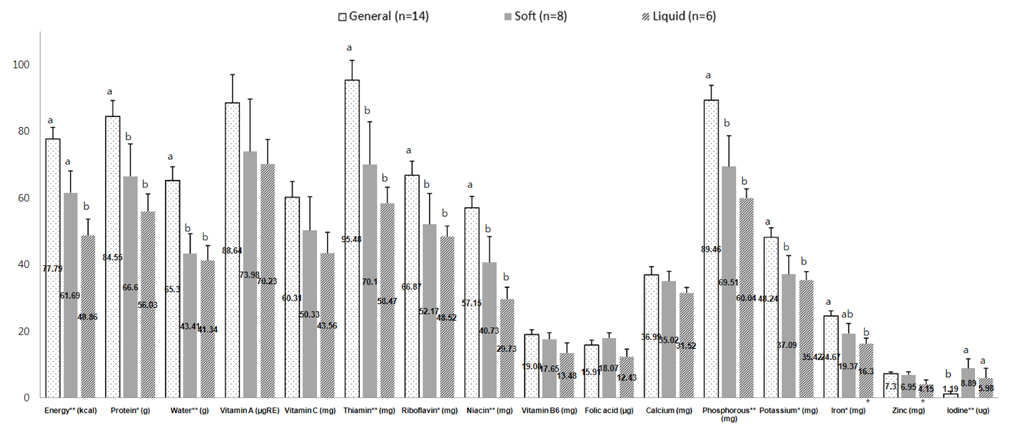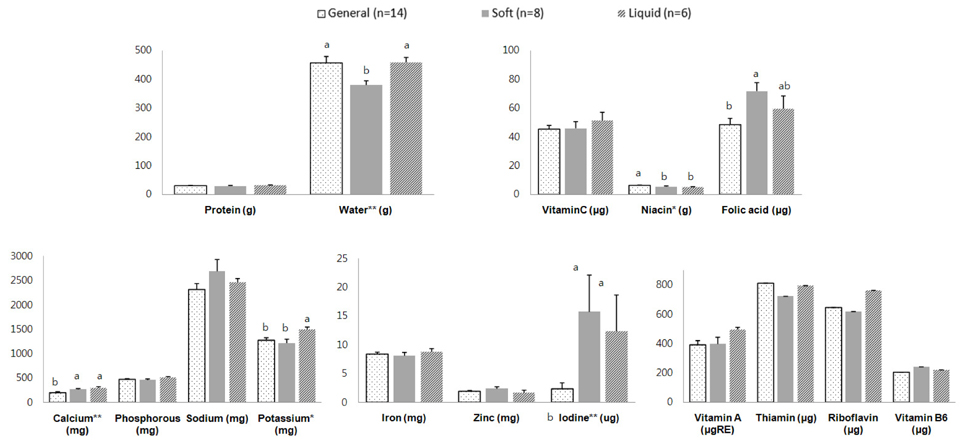Nutr Res Pract.
2019 Feb;13(1):32-40. 10.4162/nrp.2019.13.1.32.
Nutritional status of Korean elderly with dementia in a long-term care facility in Hongseong
- Affiliations
-
- 1Department of Food Science and Nutrition, Soonchunhyang University, 22 Soonchunhyang-ro, Shinchang-myun, Asan, Chungnam 31538, Korea. hskim1@sch.ac.kr
- 2Samsung Yeonhap Clinic, 662-2, Hongnam-ro, Gwangcheon-eup, Hongseong-gun, Chungnam 31538, Korea.
- KMID: 2434074
- DOI: http://doi.org/10.4162/nrp.2019.13.1.32
Abstract
- BACKGROUND/OBJECTIVES
This study investigated nutritional status of the elderly with dementia in a care facility with the aim of improving the meal quality of the facility.
SUBJECTS/METHODS
Data were collected from 30 dementia patients aged more than 65 years in a long-term care facility in Hongseong. The data were obtained from questionnaires and medical records. The food intake data was obtained using food photographs and the nutrient intakes were calculated using the CAN-Pro 5.0. The data were compared with the dietary reference intakes for Koreans (KDRIs). The nutrient density, diet quality such as nutrient adequacy ratio (NAR), mean adequacy ratio (MAR), and index of nutritional quality (INQ), as well as dietary diversity score (DDS) were evaluated. The data were analyzed using SPSS statistical programs.
RESULTS
The average daily energy intakes for men and women were much lower than the estimated energy requirements of the KDRIs. The average intakes of energy and most nutrients in the general diet group were significantly higher than those of the other two groups. Significant differences in diet quality and diet diversity were observed according to the meal type groups. The NARs of some minerals (calcium, iron, and zinc) and vitamins (vitamin B6 and folic acid) were less than 0.5 in all study groups. The NARs of protein, iron and MAR of the general diet group were significantly higher than those of the liquid diet group. The DDS scores of meats, fruits and diary food group were very low in all meal type groups, meaning that the diet qualities of the study subjects were not appropriate in all meal type groups.
CONCLUSIONS
The food intakes of the study groups showed some limitations by a direct comparison with KDRIs because of the very low physical activities of the study subjects. The diet quality and diet diversity indices suggest the need for improvements in the nutritional quality in all types of diet. Overall, new intervention strategies targeting facility residents with dementia in Korea are needed as soon as possible.
MeSH Terms
Figure
Reference
-
1. World Health Organization. International Statistical Classification of Diseases and Related Health Problems. 10th Revision. Geneva: World Health Organization;2016.2. Stevens T, Livingston G, Kitchen G, Manela M, Walker Z, Katona C. Islington study of dementia subtypes in the community. Br J Psychiatry. 2002; 180:270–276.
Article3. Prince M, Guerchet M, Prina M. The Epidemiology and Impact of Dementia: Current State and Future Trends. Geneva: World Health Organization;2015.4. Prince M, Wimo A, Guerchet M, Ali GC, Wu YT, Prina M. World Alzheimer Report 2015, the Global Impact of Dementia: an Analysis of Prevalence, Incidence, Cost and Trends. London: Alzheimer's Disease International;2015.5. Livingston G, Sommerlad A, Orgeta V, Costafreda SG, Huntley J, Ames D, Ballard C, Banerjee S, Burns A, Cohen-Mansfield J, Cooper C, Fox N, Gitlin LN, Howard R, Kales HC, Larson EB, Ritchie K, Rockwood K, Sampson EL, Samus Q, Schneider LS, Selbæk G, Teri L, Mukadam N. Dementia prevention, intervention, and care. Lancet. 2017; 390:2673–2734.
Article6. Rocca WA, Petersen RC, Knopman DS, Hebert LE, Evans DA, Hall KS, Gao S, Unverzagt FW, Langa KM, Larson EB, White LR. Trends in the incidence and prevalence of Alzheimer's disease, dementia, and cognitive impairment in the United States. Alzheimers Dement. 2011; 7:80–93.
Article7. Prince M, Bryce R, Albanese E, Wimo A, Ribeiro W, Ferri CP. The global prevalence of dementia: a systematic review and metaanalysis. Alzheimers Dement. 2013; 9:63–75.e2.
Article8. Larson EB, Langa KM. The rising tide of dementia worldwide. Lancet. 2008; 372:430–432.
Article9. Winblad B, Amouyel P, Andrieu S, Ballard C, Brayne C, Brodaty H, Cedazo-Minguez A, Dubois B, Edvardsson D, Feldman H, Fratiglioni L, Frisoni GB, Gauthier S, Georges J, Graff C, Iqbal K, Jessen F, Johansson G, Jönsson L, Kivipelto M, Knapp M, Mangialasche F, Melis R, Nordberg A, Rikkert MO, Qiu C, Sakmar TP, Scheltens P, Schneider LS, Sperling R, Tjernberg LO, Waldemar G, Wimo A, Zetterberg H. Defeating Alzheimer's disease and other dementias: a priority for European science and society. Lancet Neurol. 2016; 15:455–532.
Article10. Ministry of Health and Welfare. Prevalence rate of dementia for the Korean elderly over the age of 65 was 9.18% as of 2012, the prevalence of dementia worldwide will approximately double every 20 years [Internet]. Sejong: Ministry of Health and Welfare;2013. cited 2013 May 2. Available from: http://www.mohw.go.kr/front_new/al/sal0301vw.jsp?PAR_MENU_ID=04&MENU_ID=0403&CONT_SEQ=286138.11. National Health Insurance Service. Long-term care insurance [Internet]. Wonju: National Health Insurance Service;2015. cited 2016 February 1. Available from: http://www.longtermcare.or.kr/npbs/e/b/101/npeb101m01.web?menuId=npe0000000030.12. Korean Statistical Information Service. Number of elderly welfare facilities and living condition [Internet]. Daejeon: Korean Statistical Information Service;2015. cited 2018 June 29. Available from: http://kosis.kr/statHtml/statHtml.do?orgId=117&tblId=DT_117N_B00003&conn_path=I2.13. Suh MK, Kim H, Na DL. Dysphagia in patients with dementia: Alzheimer versus vascular. Alzheimer Dis Assoc Disord. 2009; 23:178–184.14. Easterling CS, Robbins E. Dementia and dysphagia. Geriatr Nurs. 2008; 29:275–285.
Article15. Hudson HM, Daubert CR, Mills RH. The interdependency of protein-energy malnutrition, aging, and dysphagia. Dysphagia. 2000; 15:31–38.
Article16. Mendez L, Friedman LS, Castell DO. Swallowing disorders in the elderly. Clin Geriatr Med. 1991; 7:215–230.
Article17. Callaway CW, Chumlea WC, Bouchard C, Himes JH, Lohman TG, Martin AD, Mitchell CD, Mueller WH, Roche AF, Seefeldt VD. Circumferences. In : Lohman TG, Roche AF, Martorell R, editors. Anthropometric Standardization Reference Manual. Champaign (IL): Human Kinetics Books;1988. p. 27–38.18. The Korean Nutrition Society. ietary Reference Intakes for Koreans 2015. Sejong: Ministry of Health and Welfare;2016.19. Kant AK. Indexes of overall diet quality: a review. J Am Diet Assoc. 1996; 96:785–791.20. Yoon HJ, Lee HK, Lee SK. The health status and nutrient intakes of elderly female in Daegu area. Korean J Community Nutr. 2007; 12:50–57.21. Lee MS. Nutritional status of the oldest-elderly population in Sunchang county. Korean J Community Nutr. 2009; 14:255–265.22. Kwon JS, Lee SH, Lee KM, Lee Y. Study on energy and nutrient intake and food preference of the elderly in care facilities. Korean J Community Nutr. 2016; 21:200–217.
Article23. Choi HM. Nutrition. Paju: Kyomunsa;2006. p. 584–586.24. Ahn H, Kang J, Lee H. Nutrition status of elderly female patients in long-term care hospital according to meal types and eating ability. Korean J Community Nutr. 2014; 19:187–197.
Article25. Hansen RG, Windham CT, Wyse BW. Nutrient density and food labeling. Clin Nutr. 1985; 4:164–170.26. Park GA, Kim SH, Kim SJ, Yang YJ. Health and nutritional status of Korean adults according to age and household food security: using the data from 2010–2012 Korea National Health and Nutrition Examination Survey. J Nutr Health. 2017; 50:603–614.
Article
- Full Text Links
- Actions
-
Cited
- CITED
-
- Close
- Share
- Similar articles
-
- Long-Term Care Hospital and the Role of Neurologist
- Long-term Care of Dementia
- Status of health and nutritional intake of the elderly in long-term care facilities: focus on Gwangju Metropolitan City
- Clinical Approaches to the Long-term Care Service focused on Dementia
- The Effects of Oral Health Care Education for Nursing Staff on Halitosis and Nutrient Intake of the Elderly in a Long-term Care Facility



